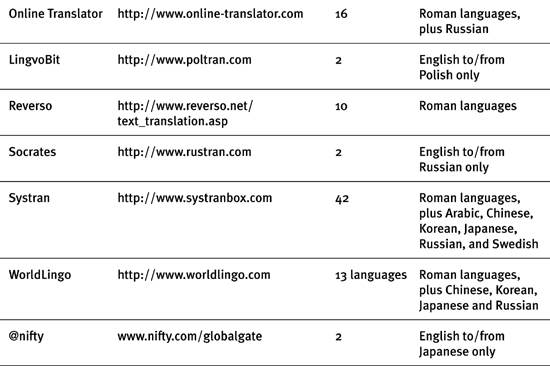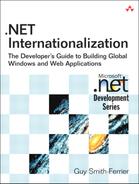B. Information Resources
THIS APPENDIX IS A COLLECTION OF RESOURCES that I have found useful or that I think you might find useful in the course of internationalizing a .NET application. It is a subjective list, and no meaning should be attached to the omission of any particular resource.
On the Web site for this book (http://www.dotneti18n.com), you will find the complete source code for this book, as well as additional code examples and utilities, a list of errata, and news of the latest editions.
Books
Developing International Software, Second Edition. Dr. International. Microsoft Press: 2002.
This is a great book. Now that you have bought .NET Internationalization, you should rush out and buy Developing International Software. The first edition of this book, Developing International Software for Windows 95 and Windows NT, by Nadine Kano, is more different than you would expect from simply changing from first edition to second edition. The first edition is available online at http://www.microsoft.com/globaldev/dis_v1/disv1.asp. Large parts of the second edition are also available online in various pages at http://www.microsoft.com/globaldev.
Resources
This section is a list of resources that are themselves a collection of resources.
Multilingual Computing Annual Resource Directory. http://www.multi-lingual.com. (Look for “Resource Directory” in the “Resources” menu.) A free downloadable PDF reference guide of language technology products and services.
I18N Gurus. http://www.i18ngurus.com. “The open internationalization resources directory.”
Webb’s World. http://www.webbsnet.com. Technical resources and translation services.
opentag.com. http://www.opentag.com. “A place for localization tools and technologies.” Includes an XML FAQ.
Tex Texin’s Web site at http://www.i18nguy.com. A considerable internationalization resource.
Magazines
Multilingual Computing & Technology. http://www.multilingual.com. It might be a stretch to say that this is the focal point of the industry, but it is certainly worth reading.
Localisation Focus. http://www.localisation.ie/publications/locfocus/index.htm.
Translation Journal. http://www.accurapid.com/journal. “A Publication For Translators by Translators about Translators and Translation.”
Machine Translation. http://www.springeronline.com/journal/10590/about.
Web Sites and FTP Sites
Forums and newsgroups: At the time of this writing, Microsoft is replacing its newsgroups with forums. At some point in the near future, the internationalization newsgroup (microsoft.public.dotnet.internationalization at msnews.microsoft.com) will be replaced with an equivalent forum at http://forums.microsoft.com/msdn. This newsgroup/forum is an excellent source of internationalization answers.
Dr. International. http://www.microsoft.com/globaldev/DrIntl/default.mspx. Various resources, FAQ, and “Ask Dr. International,” which allows you to ask internationalization questions.
The Unicode Consortium. http://www.unicode.org. All the facts on Unicode.
The World Fact Book. http://www.odci.gov/cia/publications/fact-book/index.html. A great source of information about countries, regions, and languages.
Ethnologue. http://www.ethnologue.com. Comprehensive statistics and descriptions of languages by country and “a whole lot more.” Available free online and also for purchase in book and CD-ROM versions.
Localization Glossary. ftp://ftp.microsoft.com/developr/msdn/newup/Glossary/. Translations in more than 40 languages of textual phrases used in various Microsoft products.
Postal Code Formats of the World. http://www.magma.ca/~djcl/postcd.txt. An analysis of postal code formats used in various countries.
Frank’s Compulsive Guide to Postal Addresses. http://www.columbia.edu/kermit/postal.html. An analysis of address formats and postal codes used in various countries.
The Global Source-Book for Address Data Management. http://www.grcdi.nl/book2.htm. A commercial, comprehensive analysis of address formats and information from 242 countries.
Country Codes. http://www.statoids.com/wab.html. A listing of a wide variety of codes (ISO, ITU, IOC, etc.) used in 240 countries.
Microsoft Typography Fonts and Products. http://www.microsoft.com/typography/fonts/default.aspx. Information on what products supply what fonts, and also what fonts are supplied by what products. You can use this to determine whether a user is likely to have a font you need.
Ranking of Top 20 Translation Companies. http://www.common-senseadvisory.com/members/res_cgi.php/050701_QT_top_20.php. A list of the top 20 largest suppliers of translation services.
The Savvy Client’s Guide to Translation Agencies. http://www.bytelevel.com/reports/savvy/2005.html. An annually up-dated commercial review of translation agencies and how to choose one.
Greatranslations. http://www.greatranslations.com. A Web site for translators. You can find translators and links to many free localization resources here.
Foreign Word. http://www.foreignword.com. A wealth of free language tools and resources.
The Translation Guide. http://mason.gmu.edu/~aross2. A searchable collection of 520 links to online machine translators, dictionaries, and word lists.
100 Links to Online Translators and Machine Translation Software. http://www.bultra.com/mtlinks.htm.
The Calendar Zone. http://www.calendarzone.com. An extensive collection of links to numerous calendar types.
Shtick! http://www.shtick.org/Translation. A collection of machine translations that have resulted in less than perfect but fairly amusing results.
Lost in Translation. http://www.tashian.com/multibabel. Mindless “Chinese Whispers” translation fun.
Online Machine-Translation Web Sites
Table B.1. Online Machine-Translation Web Sites


Blogs

Conferences
The Internationalization and Unicode Conference. http://www.unicode.org/conference/about-conf.html.
Microsoft Global Development and Deployment Conference. http://www.microsoft.com/globaldev/gdc/gddchome.mspx.
The Annual Internationalisation and Localisation Conference. http://www.localisation.ie.
The Annual International Workshop on Internationalisation of Products and Systems. http://www.iwips.org.
Localization World. http://www.localizationworld.com.
TRANSDEX and The Internationalization and Unicode Conference, two co-located conferences hosted by Global Meeting Services, Inc.
Translating and the Computer. http://www.aslib.com/conferences.
Organizations
Localization Industry Standards Association. http://www.lisa.org. Nonprofit organization for the globalization, internationalization, localization, and translation business community.
Association of Translation Companies. Although this is an actual name of an association (in the U.K.), it is a commonly used phrase in many countries. For example, there is the Spanish Association of Translation Companies, the Hellenic Association of Translation Companies (Greece), and the Association of Hungarian Translation Companies. If you are looking for such an association in a specific country, try searching for the same combination of words and insert the language name somewhere in the phrase (e.g., “Association of Finnish Translation Companies”).
European Union of Associations of Translation Companies (EUATC). http://www.euatc.org.
The Localization Institute. http://www.localizationinstitute.com. Providers of training, seminars, conferences, and internationalization resources.
The Globalization and Localization Association (GALA). http://www.gala-global.org. News, events, resources, and membership to GALA.
International Association for Machine Translation (IAMT). Publishes a newsletter, organizes workshops and conferences, and compiles a resource listing. The association is an umbrella for the following more local branches:
Association for Machine Translation in the Americas (AMTA). http://www.amtaweb.org.
Asian-Pacific Association for Machine Translation (AAMT). http://www.aamt.info.
European Association for Machine Translation (EAMT). http://www.eamt.org.
The Translation Automation User Society. http://www.translationautomation.com. A networking community for users of translation and localization technologies and services. As the name implies, TAUS is focused on the automation of translation.
Commercial Machine-Translation Products
TranSphere. http://www.apptek.com/products/transphere.html. Applications Technology, Inc. (AppTek). Includes an API for programmatic control of translation engines.
Direct-API. http://www.worldlingo.com/products_services/develop-ment_tools.html. WorldLingo Translations, LLC. Has an HTTP-based API for programmatic control of a translation engine. It works by sending an HTTP GET request (which includes your password parameter) to the WorldLingo server, which returns an HTTP HTML response. It is much like the HTML screen scraping examples in Chapter 9, “Machine Translation,” except that the interface is much leaner and WorldLingo has a duty to maintain compatibility.
e-Translation Server. http://www.linguatec.de/products/firm/index_en.shtml. Linguatec Language Technologies. Has an HTTP-based API for programmatic control of a translation engine.
LEC TranslateDotNet and LogoMedia. http://www.lec.com. Language Engineering Company. Provides various machine-translation solutions.
Transparent Language, Inc. http://www.transparent.com. Transparent. Provides a range of translation solutions.
Alternatives to .NET Framework Internationalization
I sincerely hope that if you have read this far, you have learned enough to internationalize your .NET applications yourself. However, if this is not the case, Table B.3 shows a few third-party products that handle part or all of the internationalization process.
Table B.3. Third-Party Alternatives to .NET Framework Internationalization

You might also like to know that Microsoft might release a similar tool into the fray. In May 2004, Microsoft announced Microsoft Application Translator (MAT). At the time of this writing, the product is on hold, but it might (or might not) be released after the publication of this book. MAT is an on-the-fly user interface translator. It intercepts Windows applications and translates their text as it is rendered in the user interface. It uses lookup tables to perform the translations. These lookup tables are included in MAT, and you can edit them and add new tables.
This innovative product has pros and cons. The pros are that the original application does not need to be modified in any way, and the source code for the original application is not required. In addition MAT is expected to be free to ISVs, developers, and users. The cons are that it simply translates bits of text—no other part of the internationalization process is handled. For example, all globalization issues are not handled; sort orders, the formatting of dates, currencies, and numbers all remain unchanged and use the original developer’s preconceptions. In addition MAT runs only on Windows XP, Windows Server 2003, and later releases. If MAT does get released, you will probably find references to it at http://www.microsoft.com and http://www.microsoft.com/globaldev.
